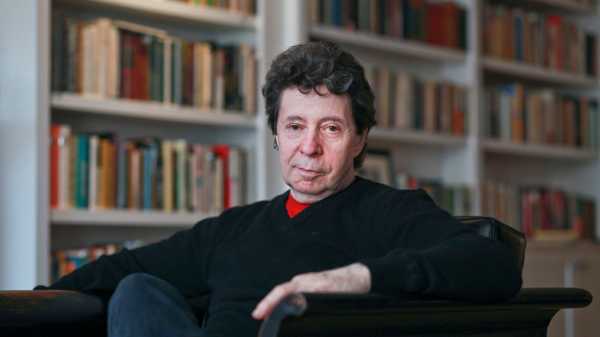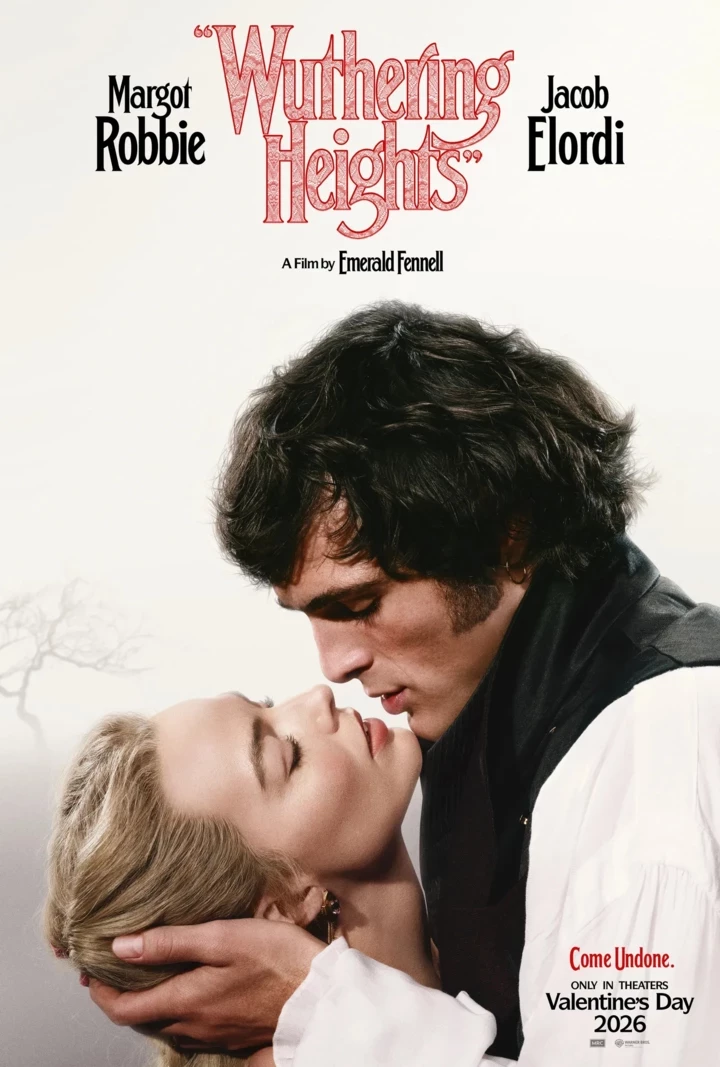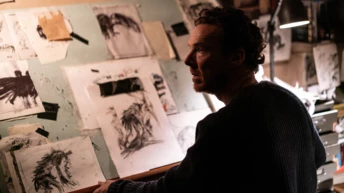
Save this storySave this storySave this storySave this story
When I arrived at the novelist Richard Price’s five-story, nineteenth-century brownstone, in East Harlem, in December, the doorbell was broken. Price and his wife, the writer Lorraine Adams, had left the door unlocked, in anticipation of my visit. The couple have lived in East Harlem since 2008. They’ve worked hard at being good neighbors, but both acknowledge what their presence means—they came as part of a wave of gentrification. In the years that they’ve lived on their block, they’ve been witness to changes both incremental and impossible to ignore. A Whole Foods that had opened nearby, on 125th Street, in 2017, was a bellwether for the shift under way. “You can’t afford a banana over there,” Price told me. “It’s game over.” But New York is always transforming because of “fucking real estate,” he went on. “When you hear the steam hiss, all of a sudden, some real-estate guy smells the coffee, smells the cappuccino, smells money, and you know this place is going to be hot. And then it’s all dentists from somewhere in New Jersey, and it’s cute shops that serve waffle cones.”
Price had slept past his alarm and skipped breakfast. As he was rooting around the fridge, he asked dryly, with a hint of bleak humor, if I wanted something to drink: a cappuccino? I accepted his offer, and he handed the cappuccino to me, in a tempered glass cup—just like in a fancy coffee shop—along with half a turkey wrap on a plate. Spread across the dining-room table were a number of children’s books—“Corduroy,” “Goodnight Moon”—that he intended as gifts for his first grandchild, who was born last year. The walls of the dining room and adjoining living room were crowded with art and mementos: two imposing Kara Walker prints; an evocative photograph of Nan Goldin and a rakish man seated in a booth at the Times Square dive bar Tin Pan Alley; a photorealistic charcoal drawing of a tiger, which was given to Price by his friend Robert Longo. There were relics of death and disappointment all over the house, too. In the guest bathroom hung a large notice from a bank notifying a small Irish town’s residents of a liquidation sale of a debt-ridden farmer’s possessions. Tucked in a corner of the dining room is what Price claims is the last photo ever taken of the rebel abolitionist John Brown, set in an ornate and rusted frame.
At seventy-five, Price is a character of a kind that the publishing industry no longer produces: a best-selling author of literary fiction raised in New York public housing. He grew up in the Bronx’s Parkside Houses in the nineteen-fifties, the son of working-class Jewish Americans, and has supported himself through his writing—novels and screenplays for both television and film—for fifty years. Price’s books are often categorized as crime fiction. But, really, he is a novelist of the city, and he re-creates, diorama-like, the intersecting struggles of laboring people in metropolitan spaces—be they cops, criminals, or working stiffs just trying to make it from one day to the next.
What most defines Price’s writing is his dialogue—a precise and comic urban argot that lends his work a credible feeling of immersion and translates well from the page to the screen. His first success as a screenwriter was for Martin Scorsese’s “The Color of Money,” for which Price garnered an Oscar nomination in 1987. Price is now best known for the cerebral, entertaining, and critically celebrated crime television that he’s written during the past two decades: he was a writer for “The Wire,” and then worked on “The Deuce” and the HBO crime miniseries “The Night Of,” all of which bear the mark of his conversational style.
Price’s tenth novel, “Lazarus Man,” a quiet and allusive work fixated on death and rebirth, was originally contracted in 2008, the year that Price and Adams moved to East Harlem. Price wanted to write something in the vein of his previous novel “Lush Life,” which is ostensibly about the murder of a young man in the Lower East Side but is really a pointillist portrait of a gentrifying neighborhood. Once he was in Harlem, though, he knew that he had to take his time. “I just didn’t know what the story was,” he told me. He needed to fulfill a quota of “living” and “hanging out” to truly know the place. “I realized right away: I just got here. What am I supposed to write, a novel called ‘Wow’?” He feared if he forced himself to start writing in 2008, he would have been nothing more than “a tour guide.” And so he waited.
What gave Price the impetus to finish “Lazarus Man” were two exceptional events—the COVID lockdown in 2020, and the Writers Guild of America strike in 2023, both of which interrupted his screenwriting work and gave him more time to write fiction. The strike forced him to think about “the importance of solidarity,” he told me. At the same time, he was “selfishly relieved that I didn’t have to write screenplays.” But then, he explained, “money became an issue and I wrote the book.”
Price works in a mode that he calls “urban panorama”—a sociologically rich realism that depicts the tensions of city life. “Lazarus Man,” though it is written in this way, is unlike anything else he has published. The novel is animated by the explosion of a Harlem tenement building and the confusion and collective soul-searching that follow, but it’s not a “thriller,” Price said, sounding proud to have written a book in which, as he put it, “nothing remarkable happens.” Composed of snapshots and fragments, it’s told in a mournful and introspective style that subverts, or mocks, the comfortable arc and resolution of a police procedural: there is a mystery (a man who went missing after the building collapse) and a cop (named Mary Roe) who is trying to solve the case, but Price is uninterested in her pursuit. He explores, instead, her reckoning with aging and divorce.
In between bites of his turkey wrap, Price told me, with a note of relief, that Hollywood wasn’t interested in the book. “I didn’t know how this book was going to go over, because there was no real drama. I didn’t want it to be a cop book,” he said. “There’s nothing to blow you away, or desperate to get your attention.” The novel was, in part, a staging ground for him to grapple with his body of work and his status as one of America’s preëminent writers of crime fiction. Price is at a point in his career when many artists confront what they’ve created through the years. “Lazarus Man” appears to be a product of this confrontation—an attempt to make the habitual and the routine new again.
In the books Price wrote during the first decade of his career, an ethnography of sorts emerges, one that picks at the resentments and disappointments of the people who raised him, whose prejudices and limited world views—their tribal fear of the Other, their fear of deviating from the norm—he wanted to better understand and resist. Initially he hoped to satisfy his parents’ desire that he choose a stable profession, and he studied industrial and labor relations at Cornell; later, he considered the possibility of law school, but his real aspirations aligned with those of his grandfather, who wrote Yiddish poetry and prose in his free time. “The smartest minds of my generation in the projects became doctors, lawyers, engineers, businessmen,” Price recalled, in a 1996 interview. “They went the route that would fulfill the economic mandate.” He knew, like so many forced to carry on the project of assimilation, that his own mandate did not line up with filial expectations. He filled his schedule with writing workshops, and his social life was spent at open mikes and cafés. He imagined himself, at least early on, as a latter-day Beat poet, but soon moved on to fiction when he decided to pursue writing more seriously.
When Price was in graduate school at Columbia, in the mid-seventies, a fellow-student, the editor Daniel Halpern, asked to publish a short story in his literary magazine, Antaeus; that piece later became a chapter in his first novel, “The Wanderers.” (The other creative-writing students, Price fondly recalls, hated the story.) After Columbia, Price, hoping that he could delay the pull of professional life, decamped to Stanford for a fellowship. Feeling homesick and stuck—he didn’t own a car, a fatal flaw in Northern California—he returned home after only three months. Back in New York, in need of money, he took a series of odd jobs while he worked on the manuscript, which he sent to Houghton Mifflin. One of his jobs was at Newark Airport. Eventually, growing impatient, he stomped out of work, in the pouring rain, to a phone booth, and called up the offices of Houghton Mifflin. To his surprise, someone answered. He was transferred to an editor, who told him, after a short hold, that the house would publish his book. “The Wanderers” came out in 1974, and Price became a literary celebrity.
At the start of his career, Price’s writing was fuelled by two sources of energy from which he would later wean himself: his autobiography and cocaine. By the end of his twenties, he had published two more books in quick succession—“Bloodbrothers” and “Ladies’ Man”—both of which drew heavily from his own experiences. He started to feel that a tyranny of the self hung over his work, and that he was running out of life material to turn into fiction. Cocaine only made this work harder, and he struggled to finish his fourth novel, “The Breaks,” which also turned out to be his most personal (and least favorite) work, concerning a liberal-arts graduate’s discomfiting return to his working-class Yonkers origins.
In the early eighties, Price found deliverance in the form of a screenwriting commission, and he wrote a script for an unmade movie, “Wingo,” which was “about a mailman who wins the lottery and how it changes his life.” Price was already a commodity in Hollywood by then (Philip Kaufman’s adaptation of “The Wanderers,” in 1979, was a financial and critical success), but his reputation as a screenwriter took off after a fortuitous meeting with Scorsese, who hired him to work on “The Color of Money.” (At the start of the decade, Price also kicked his cocaine habit.) Price’s collaboration with Scorsese was fruitful—he worked on another film (the anthology movie “New York Stories”), and on the music video for Michael Jackson’s “Bad.” The credibility that Scorsese lent to Price’s work in Hollywood allowed him to operate on a larger scale in the years to come, writing parts for Robert De Niro and Al Pacino.
Price’s later novels are indebted to his time as a journeyman screenwriter. When he was writing and researching “Sea of Love” (1989), a neo-noir starring Pacino, he discovered that an area cordoned off by police tape could be refashioned into a setting for art. From there, he set about using the crime genre, and the painfully intertwined lives of cops and criminals, to mine a deeper vein in his writing about urban life and its many inequalities. Price embedded himself into the lives of Jersey City drug dealers and the police officers assigned to chase them down, whose enforcement of the war on drugs was suffused with bitter cynicism and weariness. (He chose Jersey City over New York purely as a matter of convenience; accessing Manhattan’s crime scenes was a process full of bureaucratic red tape.)
The time that Price spent in Jersey City in the late eighties directly inspired the 1992 novel “Clockers,” his best-known book, an ingenious police procedural that intricately re-creates a city—the fictional Dempsey, to which he would return a number of times in his future works—and its pained, often ambivalent relationship with the crack-cocaine epidemic and the over-policing used to tame the crisis. The novel’s heroes—Strike, a young mid-level drug dealer, and Rocco, a middle-aged homicide detective nearing retirement—are Price’s most psychologically and stylistically distinct creations, two voices that come to represent urban life’s ur-conflicts, between Black and white, poor and upwardly mobile, police and policed.
“Clockers” was quickly optioned as a movie: Universal paid $1.9 million for the rights before the novel was published. At first, Scorsese was attached to direct, but he dropped the film to pursue a project that became “Casino.” Spike Lee stepped in as a director, and took over screenwriting duties as well. The novel, which is around six hundred pages long and filled with competing voices and perspectives, was a challenge to condense. Lee moved the story to Brooklyn from New Jersey, and made the narrative more straightforward and narrow—focussed, mostly, on one dealer’s travails.
Price returned to “Clockers” many times in our conversations. In the interviews he gave in the nineties, he seemed worried that his reputation as a screenwriter would overtake his reputation as a novelist, but he felt his career began anew after “Clockers.” (According to a 1992 Vanity Fair profile, he proudly declared to an audience at a reading for “Clockers,” “Now I’m a novelist again. You know, with a big N.”) Still, he couldn’t stay away from the screen for long. Before “Clockers” was published, his editor at Houghton Mifflin, John Sterling, had introduced him to David Simon, another writer in Sterling’s roster. Simon, realizing that Price possessed an enviable skill for both observation and fabulation, recruited him to write for “The Wire,” in early 2003.
Simon told me that he was drawn to Price’s work because Price made it easy to believe that his “characters were actually struggling with the scale of the reality in their lives, on a very, very human scale.” Price disdains the earnestness of the social-realist tradition, but he works in that mode to capture a time, a place, and a vernacular. “I’m not very good at writing about professional-class people, wealthy people, but there’s no snobbery, reverse snobbery in that,” he said. “I just don’t have the same confidence that I have writing about the people I write about.” The novelist James McBride, a fellow-chronicler of New York’s laboring classes, said of Price’s fiction, “He speaks for the unspoken as a member of the choir, not the preacher.” Simon echoed this assessment. “Richard made a conscious choice to be specific about urban America,” he told me. “Does that make what he’s doing any less literary? I don’t think it does. The places he’s writing about are where a lot of the great tension in our society exists.”
Lorraine Adams and Price met shortly after “Lush Life” was published, in 2008, at a dinner hosted by the novelist Jim Lewis. Their courtship took place during an unsettled period of Price’s life. In the midst of a divorce and in between homes, he was, in middle age, wandering, looking for someplace or someone that might allow him to feel rooted again. At the time, Price was living between Gramercy and the Lower East Side and Adams near Union Square. When they decided to move in together, she pushed for them to settle in East Harlem. She “wanted to live in an international community,” and she felt that it might be where Price belonged, too: the place of his grandmother’s birth, and not far from his own place of origin in the Bronx.
In Harlem, Adams threw herself into the work of getting to know the neighbors, and Price often tagged along. Early on, she started working at a food pantry and at the Harlem Community Rose Garden, which the couple can see from their back yard. Price, at first, felt unmoored. He spent six years wandering in and out of storefront churches and community-board meetings, and cajoling neighbors and strangers into conversation, before he found the organizing principle for “Lazarus Man.” One day, in 2014, two buildings collapsed ten blocks away from his apartment; Price could feel “vibrations in my body,” he told me. Federal regulators found that the cause of the disaster was a faulty gas line laid by a Con Ed contractor. Eight people died.
Price tracked down footage of the disaster that had been uploaded to YouTube by an amateur photographer who lived across the street from the destroyed buildings. From this man’s experience—of being knocked out of his bed, of running to the sidewalk with his camera—Price drew the basis of one of the novel’s characters, Felix Pearl, a young transplant to East Harlem whose relationship to his new neighborhood is mediated through his camera.
Researching “Lazarus Man” took Price to familiar places—namely, the back of cop cars—but he also attended neighborhood rallies organized by an anti-violence and youth-mentoring group, and rode in a hearse alongside an undertaker to see how a dead body was slowly transported from place to place. These experiences inspired two other characters: Calvin Ray, a reformed criminal turned community activist, and Royal Davis, the owner of a failing funeral home, who sees the building’s collapse as a way to save his business. A news story about a Bangladeshi woman who was rescued after seventeen days trapped in the wreckage of a collapsed garment factory gave Price the novel’s central drama and character: an ordinary man saved from death, Anthony Carter. Mixed-race, newly sober, downwardly mobile, recently divorced, Carter is a quintessential Price hero, an ambivalent figure at the center of a city’s divisions and tensions.
The people Price writes about in “Lazarus Man” are precariously employed, alienated, and, for the most part, middle-aged—people who are more or less absent in contemporary fiction. And the Harlem he’s rendered here is a place of flux. One can see, he writes, an “increasing mix and match of the poor and the better off living within a few yards of each other; brownstones cut up into kitchenettes sitting next to ones that were single-family intact; apartment houses that had gone co-op sharing an outer wall with ones where the majority of tenants received some kind of government assistance.”
When I asked Price whether the book had been affected by the George Floyd protests, he tried to strike a note of equanimity. “The thing is that I’m not pro-police or anti-police. And what I realized doing ride-alongs with cops, it’s not so much you love the police or you hate the police. It’s [about] what you see in the back seat of a police car.” When “there’s crisis,” police are going to be there, Price said, and he wanted to “have entry into lives that you wouldn’t normally have otherwise.”
Over the years, Price has seen the same cycles of violence brought on by rampant police abuse, and he’s glad that “people are more sensitive,” because now “they’re more alert” and “angry.” Still, the country’s changing mores have been challenging to navigate. Adams would tell me later that she thinks Prince spent as much time on the book as he did because they were both “grappling with” the radical transformation that has taken place in the discourse around race, class, and policing in America. “Would ‘Clockers’ even be published right now?” Price wondered out loud. He told me he set the new novel in 2008 because it was a period in New York, and in the world, that he better understood: “There was less policing of language. There was less of a sense that you can’t write about this. You have no right to write about this.” He wanted to write about a time in which his impressions of Harlem were just forming. “It gave me a little freedom.”
Etched into Price’s book is his sense that he still deserves the license to write about people unlike him, to describe realities that are not his own. When asked why he takes photos of people without their explicit permission, the character of Felix Pearl responds, “I can’t speak for others . . . but when I take a picture . . . it’s to remind me where I’ve been in my life.”
That admission might double as a statement of purpose for Price. Though his novels have always explored the inequities of urban life, the time that he spends on the street, looking for stories, is in the service of fulfilling his need to record experience—that of the people he meets, but also his own. With “Lazarus Man,” Price has settled for something appropriately photographic—snapshots of human relations and their inherent contradictions, presented to his readers without the need to resolve them.
Simon underlined the modest ambitions of “Lazarus Man,” saying, “There are no big satisfactions at the end of Richard’s novels.” In the wake of the building collapse, the novel’s ostensible hero, Anthony Carter, is asked to speak at a rally for his neighbors, all rattled by the sudden catastrophe. He tells the crowd, “All I wanted to do as soon as I could breathe air that wasn’t packed with dirt, all I wanted to do was to live and live and live.” But, by the end of the novel, his escape from death has more or less returned him to where he started, with a yearning but mostly thwarted sense that his “next random conversation would be the trigger for some kind of epiphany that would show him a new way to be.”
Before I left Price and Adams’s home, I asked them to walk with me to the Harlem Rose Garden. It was a cold day, and nothing was set to bloom for a long while. In the garden, stepping across patches of frozen soil, Adams pointed to all the work she hoped to get done once it was warm again.
Earlier that day, Price had told me about another walk that he and Adams had taken, from their home to Mott Haven, at the southern tip of the Bronx. Price was struck, he told me, by what real-estate speculators had done—the new, appealing names (the “Piano District”) that they’d slapped onto neighborhoods he had studiously avoided as a youth, and the retail renaissance of local businesses. “Real estate is violence—it’s about evicting people. It’s about destroying neighborhoods, or redefining neighborhoods.” The world of his grandparents, his parents, is gone, or, worse, “somebody put a lot of costume makeup” on it. “I actually heard some, some tour guide outside the Apollo Theatre, who had a bunch of Midwesterners on a walking tour of Harlem,” he recalled. “I heard her say, ‘Well, I’ve got to tell you, take a really good look at what you see, because I guarantee you, when you come back the next time, if you ever come back, you ain’t going to see it. It’s going to be gone.’ ” ♦
Sourse: newyorker.com







